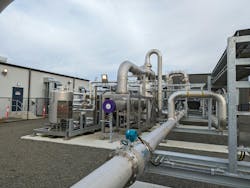"How They Made it Work" is a column that features some of the latest technological advancements in the chemical process industry. Here, Chemical Processing asks experts from various technology providers to provide insight into their innovations and how they're helping chemical manufacturers operate their plants more efficiently and effectively.
Biogas contains hydrogen sulfide (H2S) gas, which condensates out to form a highly corrosive liquid. The HRS biogas dehumidification system (BDS) removes water from biogas, protecting combined heat and power (CHP) engines and generator sets from corrosion and cavitation.
The following example of a wastewater treatment plant in Melbourne, Australia, is also applicable to the chemical industry’s efforts to manage wastewater more effectively and sustainably.
Company
HRS Heat Exchangers
Technology
The HRS biogas dehumidification system removes water from biogas, protecting CHP engines and generator sets from corrosion and cavitation. It condenses more than 90% of the water present in biogas by reducing the temperature to leave a clean, green gas. The addition of heat regeneration technology means the cold biogas produced can be used to pre-cool the incoming warmer biogas. This reduces the load on the final cooling heat exchanger and saves valuable energy.
Development, design and purpose
Biogas contains H2S gas, which condensates out to form a highly corrosive liquid. Including a system to remove most of the moisture from the gas was therefore essential to minimize the amount of corrosion and degradation of the power station generators, while also limiting operational downtime and reducing the need to import electricity from the grid. The BDS supplied to Melbourne Water has a maximum capacity of 4,161 m3/hr. (410,380 lbs./hr.), while the inclusion of an energy-recovery section subsequently reduces the eventual chiller load by 30%, improving the overall energy footprint of the whole project.
Significance in wastewater treatment
In 2020, Melbourne Water began a project with John Holland-KBR Joint Venture to upgrade the biogas handling system at its Eastern treatment plant in Melbourne to make it more efficient, resilient and future proof. Expanding capacity, preventing corrosion and sedimentation and extending the working life of equipment were key aims, with specific requirements to remove liquid droplets and moisture and to minimize the size and cost of any necessary cooling system.
Sewage transfer and treatment are responsible for around 85% of Melbourne Water’s total greenhouse gas emissions and contributing to the company’s net-zero commitment was a main target.
Unique features
The HRS BDS works by reducing the temperature of the raw biogas from around 40°C to approximately 5-7°C, condensing more than 90% of the water volume. It uses a chiller system, which supplies a coolant that is transferred to heat exchangers. Biogas flows on the product side of the exchanger, while the coolant flows on the service side. As the biogas cools, the water condenses from the gas, leaving a clean and dry biogas ideal for use in CHP engines.
Heat recovery uses the resulting cold biogas to pre-cool the warmer incoming biogas, reducing chiller load by 30%.
Success story
From being awarded the contract in July 2021, it took less than 12 months for HRS to install the bespoke BDS on site, with commissioning completed in June 2022.
Since commissioning, the HRS BDS has met its performance targets, with no breakdowns or interventions. The upgrade project has improved the reliability and quality of the biogas supply to the power station at the effluent treatment plant, providing more confidence in its ability to provide more than 36,000 MWh (approximately 130TJ) of thermal energy for process heating. This means a reduced reliance on natural gas, making the overall operation more self-sufficient and reducing overall emissions.
About the Author

Ella Taghavi
Having joined HRS Heat Exchangers Australia five years ago, Ella Taghavi has progressed from her initial role as sales engineer to project manager and the technical lead for the company. She holds an honours degree in mechanical engineering.

